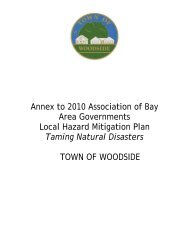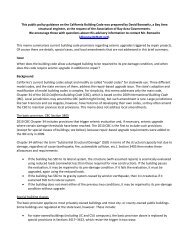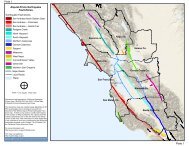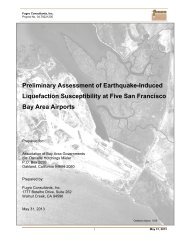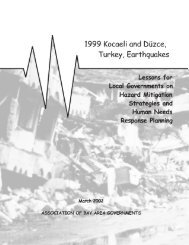Safe Enough to Stay - ABAG Earthquake and Hazards Program
Safe Enough to Stay - ABAG Earthquake and Hazards Program
Safe Enough to Stay - ABAG Earthquake and Hazards Program
- No tags were found...
Create successful ePaper yourself
Turn your PDF publications into a flip-book with our unique Google optimized e-Paper software.
<strong>Safe</strong> <strong>Enough</strong> <strong>to</strong> <strong>Stay</strong>Several relevant lessons for San Francisco emerge from theexperiences of disasters in other communities:1. Rebuilding housing takes a long time, even if the percentage ofunits rendered uninhabitable is relatively small. It <strong>to</strong>ok at least twoyears for a significant portion of housing <strong>to</strong> be replaced in all of theprofiled disasters for which information was available. It <strong>to</strong>ok muchlonger <strong>to</strong> rebuild in some communities. After the 1995 earthquake inKobe, Japan — an area often cited <strong>to</strong> be similar <strong>to</strong> the Bay Area — it<strong>to</strong>ok the city five <strong>to</strong> 10 years <strong>to</strong> reach its rebuilding goals.2. Multifamily <strong>and</strong> affordable housing is much more difficult<strong>and</strong> slower <strong>to</strong> replace than single-family, market-rate housing.Financing <strong>and</strong> legal issues are some of the many fac<strong>to</strong>rs that slowdown this work. After the Bay Area’s Loma Prieta earthquake in1989, it <strong>to</strong>ok seven <strong>to</strong> 10 years <strong>to</strong> replace all of the damagedaffordable housing. If lost, some affordable housing might never bereplaced, leading <strong>to</strong> a significant shift in post-event population.3. Large losses of housing lead <strong>to</strong> permanent losses of population.The table includes two events with housing losses greater than 25percent: Hurricane Katrina <strong>and</strong> the Kobe earthquake. Both of theseevents caused large population losses <strong>and</strong> demographic shifts.However, a number of events where housing losses were muchsmaller — such as the Christchurch earthquakes in New Zeal<strong>and</strong> <strong>and</strong>Hurricane Andrew’s impacts in Florida — produced large losses inpopulation as well.4. Interim housing matters. After the 1994 Northridge earthquakein Los Angeles, most of the people displaced were able <strong>to</strong> relocatenearby due <strong>to</strong> the area’s pre-earthquake 9.3 percent vacancy rate.Vacant rental units served as interim housing. In San Francisco, thevacancy rate is typically much tighter, currently 4 percent, 22 meaningthat the city will need more active measures <strong>to</strong> house its displacedresidents over longer periods.It is clear that very large housing losses, such as those that occurredafter the Kobe earthquake <strong>and</strong> Hurricane Katrina, devastate acommunity <strong>and</strong> lead <strong>to</strong> a slow, difficult recovery. Studies followingmajor disasters in the United States, Japan <strong>and</strong> elsewhere haveshown that individuals <strong>and</strong> families enduring interim <strong>and</strong> irregularhousing situations for months <strong>and</strong> years after a disaster are morevulnerable <strong>to</strong> physical, social <strong>and</strong> mental disorders, including suicide,substance abuse, <strong>and</strong> physical <strong>and</strong> verbal abuse. 23 However, evenwithout catastrophic losses, the disaster case studies included inthe table also show that housing losses on the order of 5 percent or22 Data from Reis, Inc. as quoted in “U.S. Housing Market Conditions: PacificRegional Report, HUD Region IX – 1st Quarter 2011.” www.huduser.org/portal/regional.html. Vacancy rates are continuing <strong>to</strong> tighten due <strong>to</strong> high dem<strong>and</strong> fromgrowing employment sec<strong>to</strong>rs, potentially exacerbating interim-housing needsshould a disaster strike.less, such as those seen in the Christchurch earthquakes, HurricaneAndrew, <strong>and</strong> the Northridge <strong>and</strong> Loma Prieta earthquakes, alsocontribute <strong>to</strong> a range of undesirable outcomes. These include largelosses of population, large job losses, protracted time frames forrebuilding <strong>and</strong> heavy impacts on affordable housing.After examining this data, we believe that San Francisco wouldexperience significant consequences even if only 5 percent of itshousing units were unusable after a future earthquake, given thecity’s low vacancy rates, density <strong>and</strong> limited capacity for interimhousing. If more housing were damaged, the potential social <strong>and</strong>economic consequences could be devastating.We conclude that SPUR’s performance target of 95 percent shelter inplace is appropriate.How will San Francisco’sneighborhoods be impacted bythe expected earthquake?San Francisco’s housing will be heavily damaged after future largeearthquakes. San Francisco’s Department of Building Inspectionrecently completed a major study — the Community Action Planfor Seismic <strong>Safe</strong>ty (CAPSS) 24 — that analyzed earthquake risk forthe city’s privately owned buildings, including housing. The CAPSSproject estimated that after a magnitude 7.2 earthquake on the SanAndreas Fault, approximately 25 percent of the city’s housing unitswould not be safe for residents <strong>to</strong> occupy. 25 In other words, wecurrently expect 75 percent of residences <strong>to</strong> be available for shelteringin place after the expected earthquake. This means that residents ofmore than 85,000 units would need <strong>to</strong> seek alternate housing untiltheir units are repaired or replaced, which would take years.SPUR has refined the CAPSS estimates of housing damage sothat they could be reported in greater detail by neighborhood <strong>and</strong>23 Enarson, Elaine, Alice Forthergill <strong>and</strong> Lori Peek, “Gender <strong>and</strong> Disaster:Foundations <strong>and</strong> Directions,” Chapter 8 in H<strong>and</strong>book of Disaster Research (NewYork, NY: Springer, 2007); Tatsuiki, Shigeo, “Long-Term Life Recovery ProcessesAmong Survivors of the 1995 Kobe <strong>Earthquake</strong>: 1999, 2001, 2003, <strong>and</strong> 2005Life Recovery Social Survey Results,” Journal of Disaster Research vol 2., no. 6(2007): 484–501.24 For more information about CAPSS, see www.sfcapss.org.25 This estimate considers damage from ground shaking <strong>and</strong> liquefaction,but does not include effects of fires sparked by earthquakes. Fire damageafter earthquakes varies significantly based on conditions at the time, such asweather, wind <strong>and</strong> damage <strong>to</strong> fire-fighting resources. CAPSS ran multiple postearthquakefire scenarios, varying these <strong>and</strong> many other conditions. On average,more than 70 fires would be expected <strong>to</strong> ignite after an event this size, burning8.7 million square feet of building space that had not already been destroyed byshaking. About two-thirds of all building space in San Francisco is residential.Assuming that about two-thirds of the burned area is in residential buildings,nearly 6,000 additional units are projected <strong>to</strong> be lost <strong>to</strong> fire, although lossescould be much higher or lower.12 SPUR Report > January 2012




